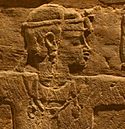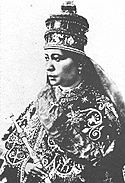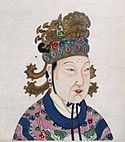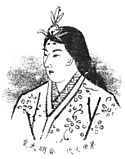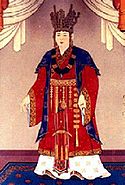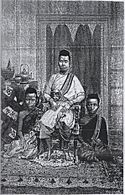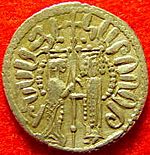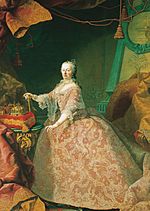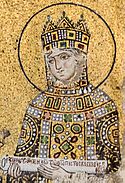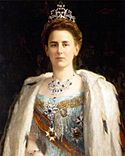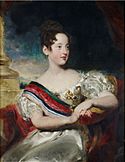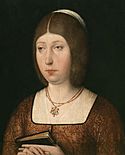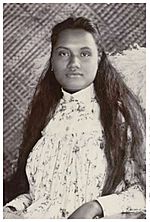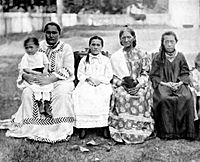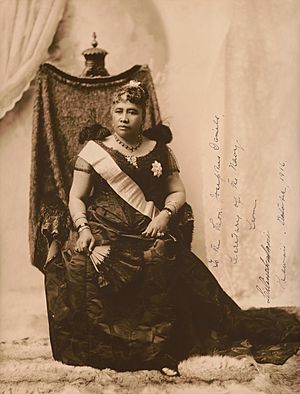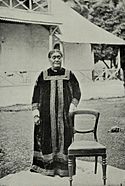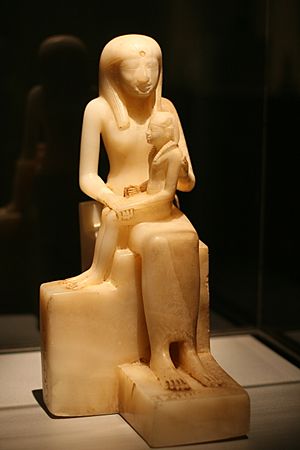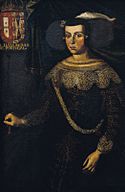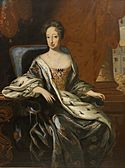List of women rulers facts for kids

This is a list of current and former female monarchs, including Queens regnant, Empresses regnant, Pharaohs and monarchs by other titles (Grand Duchess, Princess etc.). If the Queen ruled as a regent, this is indicated by "(regent)" following the name. Where a queen had no powers but only the title, "(titular)" is added instead.
A queen consort being styled a queen by virtue of marrying a monarch are not included.
The following is an incomplete list of queens who are well known from popular writings, although many ancient and poorly documented ruling queens (such as those from Africa and Oceania) are omitted. Section 1 lists Queens regnant: Queens who ruled in their own right. Section 2 lists Queens regent: Queens who have ruled on behalf of a monarch who was a minor, absent or incapacitated. Section 3 includes Legendary Queens. Section 4 lists Titular Queens: Queens who ruled in their own right, but had no constitutional standing or regal powers while in power. Section 5 lists various female leaders who were referred to as "Chieftainess."
Contents
- Queens regnant
- Africa
- America
- Asia
- Europe
- Oceania
- Female regents
- Legendary Queens
- Titular Queens
- Chieftainess
Queens regnant
Africa
North Africa
Algeria
- Kahina (ruled c. 690–703)
Egypt
- Nitocris of the Sixth Dynasty - Nitocris is mentioned within Herodotus' book Histories as being the last Pharaoh of the Sixth Dynasty of Egypt; some contest her historicity.
- Sobekneferu (r. 1806-1802 BC) of the Twelfth Dynasty - Sobekneferu was the first confirmed female ruler of Egypt, although Nitocris may have ruled in the Sixth Dynasty, and there are five other women who are believed to have ruled as early as the First Dynasty
- Hatshepsut (c. 1479-1458 BC) of the Eighteenth Dynasty
- Neferneferuaten of the Eighteenth Dynasty (possibly Nefertiti or Meritaten or Neferneferuaten Tasherit)
- Twosret (d. 1189 BC) of the Nineteenth Dynasty
Ptolemy II instituted a new practice of brother-sister marriage when he married his full sister, Arsinoe II. They became, in effect, co-rulers, and both took the epithet Philadelphus ("Brother-Loving" and "Sister-Loving"). Because of this custom many of the kings ruled jointly with their spouses, who were also of the royal house. The only Ptolemaic Queens who ruled alone were Cleopatra II, Berenice III and Berenice IV. Cleopatra VI did co-rule, but it was with another female, Berenice IV. Cleopatra VII officially co-ruled with Ptolemy XIII Theos Philopator, Ptolemy XIV, and Ptolemy XV, but effectively, she ruled Egypt alone
- Arsinoe II (277-270 BC)
- Berenice II (246-222 BC)
- Arsinoe III (220-204 BC)
- Cleopatra I (193-176 BC)
- Cleopatra II (175-164, 163–127, 124-116 BC)
- Cleopatra III (142-131, 127-101 BC)
- Cleopatra IV (116-115 BC)
- Berenice III (101-88, 81-80 BC)
- Cleopatra V (79-69 BC)
- Cleopatra VI (58-57 BC)
- Berenice IV (58-55 BC)
- Cleopatra VII (51-30 BC)
- Arsinoe IV (48-47 BC)
- Shajar al-Durr (ruled 1250)
Libya
- Cleopatra Selene II (ruled 34–30 BC) - also known as Cleopatra VIII. In 75 BC, Cyrene became part of a Roman province, but it was restored to the Ptolemies by Mark Antony in 37 BC. In 34 BC Cleopatra VII and Antony's daughter, Cleopatra Selene II, was made Queen of Cyrene, but the city returned to Rome following Augustus' conquest of Egypt in 30 BC
Sudan
Kandake was a title for queens, queen mothers, and queens consort in Nubia, but ruling Kandakes may have included:
- Shanakdakhete (ruled 177–155 BCE)
- Amanirenas (ruled 40–10 BCE)
- Amanishakheto (ruled c. 10 BCE–1 CE)
- Nawidemak
- Amanitore (ruled 1–20 CE)
- Amanitaraqide
- Amanikhatashan (ruled 62–85)
- Amanipilade
West Africa
Benin
- Hude (ruled 1746–1752)
Gambia
- Elizabeth II of The Gambia (reigned 1965–1970)
Ghana
- Elizabeth II of Ghana (reigned 1957–1960)
- Amoako Atta Yiadom (ruled 1770–1793), Denkyirahene
- Ama Serwah (ruled 1838–1846), Dwabenhene
- Unknown Dwabenhene (ruled 1846-18??)
- Nana Juaben Serwah II (ruled 1959–19??), Dwabenhene
Guinea-Bissau
- Okinka Aurelia Correia (ruled r. 1830-1874/1879)
- Okinka Pampa Kanyimpa (ruled c. 1910–1930)
- Okinka Juliana (ruled early 1900s)
- Okinka Idiana Ibop (ruled until 1920s)
Côte d'Ivoire
- Pokou (ruled 1750–1760) - Queen and founder of the Baoule tribe
- Akwa Boni (ruled 1760–1790), Pokou's niece who succeeded her to the throne
Nigeria
- Elizabeth II of Nigeria (1960–1963)
- Further information: Kabara (title)
- Kufuru
- Ginu
- Yakumo
- Yakunya
- Wanzamu
- Yanbamu
- Gizir-gizir
- Inna-Gari
- Daurama
- Ga-Wata
- Shata
- Fatatuma
- Sai-Da-Mata
- Ja-Mata
- Ha-Mata
- Zama
- Sha-Wata
- Daurama II
- Emose (584-600)
- Orrorro (600-618)
- Pupupu, founder and ruler of the Ondo Kingdom c. 1510.
- Amina - There is controversy among scholars as to the date of her reign, one school placing her in the mid-15th century, and a second placing her reign in the mid to late 16th century
Senegal
- Further information: Lingeer
Lingeer's leadership activities were carried out at the highest tier, as a co-monarch.
- Lingeer Fatim Beye (ruled c. 1335)
- Lingeer Ndoye Demba (ruled c. 1367) - she was the founder of the Serer Joos Maternal Dynasty
- Lingeer Ngoné Dièye
- Njembot Mbodj
- Ndaté Yalla Mbodj
- Lingeer Selbeh Ndoffene Joof
Sierra Leone
- Elizabeth II of Sierra Leone (1961–1971)
- Fatima Brima Kama, Alikali (ruled 1826–1840), Bai
Central Africa
Angola
- Mussasa (17th century)
- Tembandumba

- Mwongo Matamba (ruled ?–1631) - she was captured and deposed by Ana Nzinga in 1631
- Ana I de Sousa Nzinga Mbande (ruled 1631–1663)
- Barbara (ruled 1663–1666)
- Verónica I Guterres Kandala Kingwanga (ruled 1681–1721)
- Ana II (ruled 1742–1756)
- Verónica II (ruled 1756–1758)
- Ana III (ruled 1758–1767)
- Vamwene Naama
- Vamwene Yamvu
- Vamwene Mbaao ya Chinguli (ruled 1500s-early 1600s)
- Vamwene Kaamba ka Mbaao
- Vamwene Mukenge wa Lweembe, Livindamo
- Ana de Sousa Nzinga Mbande (ruled 1624–1626 and 1657–1663)
- Mukambu Mbandi (ruled 1663–1671)
Kingdom of Jinga
Cameroon
- Ngoungoure, queen of Bamum (ruled 1865) - her rule lasted 30 minutes
Congo
There were two female monarchs during Kongo Civil War.
- Ana Afonso de Leão, queen of Kinlaza
- Suzana de Nóbrega, queen of Kimpanzu
East Africa
Comoros
- Alimah I (ruled during the 16th century - unknown start date, reigned ended in c. 1590)
- Alimah II (ruled 1632–1676)
- Alimah III (ruled 1676–1711)
- Alimah IV (ruled 1788–1792) - she was the de facto ruler of Anjouan with sultan Abdallah I during his reigns in 1782-1788 and 1792-1796
- Amina (1590-1596)
- Aisa (1700-1714)
- Monavo Fani (1714-1720)
Bamboa
- Nyau wa Faume
- Fey Beja waWabeja, Mfalme
- Ja Mhaba, Mfalme
- Hadija bint Ahmed, Mfalme
- Raketaka Jombe Sudy (ruled 1842–1865 and 1874–1878) - she also ruled as regent twice, 1865-1868 and 1871–1874. After 1851 she took the name of Jumbe Fatima bint Abderremane
- Salima Machamba bint Saidi Hamadi Makadara (ruled 1888–1909)
Ethiopia
- Zewditu (ruled 1916–1930)
- Māti Layla Abūd (14th century)
Kenya
- Elizabeth II of Kenya (1963–1964)
Names taken from Female Rule in the Indian Ocean World (1300-1900).
- Mwana Masuru
- Maryamu
- Mwana Mkisi
- Mwana Inali
- Mwana Darini binti Bwana Mkuu bin Abubakar
- Asha binti Muhammad
- Mwanai Mimi
- Mwana Khadija binti Omari
Madagascar
- Rangita (ruled 1520–1530)
- Rafohy (ruled 1530–1540)
- Ranavalona I (ruled 1828–1861)
- Rasoherina (ruled 1863–1868)
- Ranavalona II (ruled 1868–1883)
- Ranavalona III (ruled 1883–1897)
The female monarchs of Madagascar traditional states were:
- Ramananandrianjaka Rambolamasoandro
- Rabehety
- Andrianaginarivo (ruled 1777–1778)
- Tombola (ruled 1778)
- Ravahiny (ruled 1778–1808)
- Oantitsy (ruled 1832–1836)
- Tsiomeko (ruled 1836–1840)
- Bibiasa
Bemihisatra
Bemazava
- Irana Andriamamelonarivo
- Tsiresy I Andriamanomponarivo
- Tsiresy II Nenimoana
- Ambary of Antankarana
- Soanaomby
Imarovatana
- Ramanandrianjaka II Ravorombato
Mauritius
- Elizabeth II of Mauritius (1968–1992)
Somalia
- Queen Ati of Land of Punt, the co-ruling woman of Punt
South Sudan
- Abudok, the eighth ruler (and only queen) of the Shilluk
Tanzania
- Elizabeth II of Tanganyika (1961–1962)
Names taken from Female Rule in the Indian Ocean World (1300-1900).
- Mwana Aziz
- Mwana Miveni
- Mwana Aisha
- Mwana Fatuma binti Darhash
- Mwana Hadiya
- Mwana Mize binti Muaba
- Mwana Mwema
- Fatuma binti Yussuf
- Mwana wa Mwana
- Mwanzuani
- Mwana Khazija binti Ngwali
- Fatuma binti Ali
- Sabini binti Ngumi
Uganda
- Elizabeth II of Uganda (1962–1963)
- Masamba of Bunyoro (early 17th century) (5 Years)
South Africa
Malawi
- Elizabeth II of Malawi (1964–1966)
Namibia
- Nandundu (ruled 1830–1832)
South Africa
- Elizabeth II of South Africa (1952–1961)
The Modjadji or Rain Queen is the hereditary queen of Lobedu, the people of the Limpopo Province of South Africa. The succession to the position of Rain Queen is matrilineal, meaning that the Queen's eldest daughter is the heir, and that males are not entitled to inherit the throne at all. The Rain Queen is believed to have special powers, including the ability to control the clouds and rainfall.
- Majaji (ruled c. 350 AD)
- Maselekwane Modjadji (1800–1854)
- Masalanabo Modjadji (1854–1894)
- Khetoane Modjadji (1895–1959)
- Makoma Modjadji (1959-1980)
- Mokope Modjadji (1981-2001)
- Makobo Modjadji (2003-2005)
Zambia
- Mamochisane, queen of Makololo tribe (c. 1851)
America
North America
Canada
- Victoria (ruled 1837–1901)
- Elizabeth II of Canada (reigned 1952–)
Mexico
- Tlapalizquixochtzin (ruled late 15th-early 16th century)
- Ix Yohl Ik'nal (ruled 583–604)
- Sak K'uk', also known as Muwaan Mat (ruled 612–615)
- Azcasuch (ruled late 15th-early 16th century)
Central America and the Caribbean
Antigua and Barbuda
- Elizabeth II of Antigua and Barbuda (reigned 1981–)
Bahamas
- Elizabeth II of the Bahamas (reigned 1973–)
Barbados
- Elizabeth II of Barbados (reigned 1966–2021)
Belize
- Elizabeth II of Belize (reigned 1981–)
Grenada
- Elizabeth II of Grenada (reigned 1974–)
Guatemala
- Wac Chanil Ahau, also known as Lady Six Sky
- Unen Bahlam (ruled c. 317)
- Lady of Tikal (ruled 511–527?)
Jamaica
- Elizabeth II of Jamaica (reigned 1962–)
Saint Kitts and Nevis
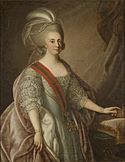
- Elizabeth II of Saint Kitts and Nevis (reigned 1983–)
Saint Lucia
- Elizabeth II of Saint Lucia (reigned 1979–)
Saint Vincent and the Grenadines
- Elizabeth II of Saint Vincent and the Grenadines (reigned 1979–)
South America
Brazil
- Maria I (ruled 1815–1816)
Guyana
- Elizabeth II of Guyana (reigned 1966–1970)
Trinidad and Tobago
- Elizabeth II of Trinidad and Tobago (reigned 1962–1976)
Asia
East Asia
China
- Wu Zetian (Chinese: 武則天) - Empress regnant of China, ruling from 690 to 705. She was the only orthodox reigning empress in the history of China.
Although Wu Zetian is the only undisputed empress regnant recognized in orthodox Chinese historiography, there are two other documented cases of a woman holding the title of "Empress regnant" in Chinese history:
- Daughter of Emperor Xiaoming of Northern Wei (Chinese: 元氏 (北魏孝明帝女); ruled 1–2 April 528) - during Northern Wei Dynasty, Empress Dowager Hu, after her son Emperor Xiaoming of Northern Wei's death, falsely declared Emperor Xiaoming's daughter to be a son and declared the daughter to be the new ruler, but almost immediately revealed that the child was in fact female, and thereafter declared Yuan Zhao, the young son of Emperor Xiaoming's cousin Yuan Baohui (元寶暉) emperor. Emperor Xiaoming's daughter is also therefore not usually considered a true monarch.
- Chen Shuozhen (ruled 653) - She led a peasant uprising in 653. During the rebellion, she declared herself Emperor.
In Tibet, there was "Kingdom of Women (Chinese: 女國)" related to Sumpa. Several ruling queens who ruled there were recorded in Chinese history books.
- Supi Mojie (Chinese: 蘇毗末羯)
- Dajiawa (Chinese: 达甲瓦)
- Qibangsun (Chinese: 弃邦孙)
- Tangpangshi (Chinese: 湯滂氏)
- Lianbi (Chinese: 斂臂)
- Eyaner (Chinese: 俄琰兒)
- Zhaoyefu (Chinese: 趙曳夫)
- Nugandaširi (Chinese: 努溫答失里) (ruled 1460–1467) - In Kara Del of Xinjiang, there was no king for eight years and queen mother Nugandaširi ruled there alone.
Japan
- Queen Himiko, of Yamatai (ruled 189–248)
- Queen Toyo, of Yamatai (ruled 3rd century)
- Empress Suiko (554–628), (ruled 593–628) — first ruling empress
- Empress Kōgyoku (594–661), (ruled 642–645 and 655–661) — formerly Princess Takara (Empress Consort of Jomei)
- Empress Jitō (645–702), (ruled 690–697)
- Empress Genmei (661–721), (ruled 707–715)
- Empress Genshō (680–748), (ruled 715–724) — formerly Princess Hidaka
- Empress Kōken (718–770), (ruled 749–758 and 764–770)
- Empress Meishō (1624–1696), (ruled 1629–1643)
- Empress Go-Sakuramachi (1740–1813), (ruled 1762–1771) — last ruling empress
Korea
South Asia
Bangladesh
- Kuverami (ruled 334–341)
- Umavira (ruled 341–361)
- Nitichandra (ruled 520–575)
- Pritichandra (ruled 578–90)
India
- Ballamahadevi (ruled 1275–1292) - she ruled with her son Nagadevarasa
- Further information: Arakkal Beevi
- Ali Raja Bibi Harrabichi Kadavube (ruled 1728–1732)
- Ali Raja Bibi Junumabe I (ruled 1732–1745)
- Ali Raja Bibi Junumabe II (ruled 1777–1819)
- Tribhuvana Mahadevi I (ruled 845–850)
- Tribhuvana Mahadevi II (ruled 890–896)
- Tribhuvana Mahadevi III (ruled 896–905)
- Gauri Mahadevi (ruled c. 910–916)
- Dandi Mahadevi (ruled c. 916–936)
- Vakula Mahadevi (ruled c. 936–940)
- Dharma Mahadevi (ruled c. 940–950)
- Qudsia Begum (ruled 1819–1837) - in 1819, 18-year-old Qudsia Begum (also known as Gohar Begum) took over the reins after the assassination of her husband, Nawab Muiz Muhammad Khan Bahadur. She was the first female ruler of Bhopal. She declared that her 2-year-old daughter Sikander would follow her as the ruler; none of the male family members dared to challenge her decision. She ruled till 1837, when she died having adequately prepared her daughter for ruling the state.
- Begum Sultan Shah Jehan (ruled 1844–1860 and 1868–1901) - Shahjahan was the only surviving child of Sikandar Begum, sometime Nawab of Bhopal by correct title, and her husband Jahangir Mohammed Khan. She was recognised as ruler of Bhopal in 1844 at the age of six; her mother wielded power as regent during her minority. However, in 1860, her mother Sikandar Begum was recognised by the British as ruler of Bhopal in her own right, and Shahjahan was set aside.
- Begum Nawab Sikandar (ruled 1860–1868)
- Begum Kaikhusrau Jahan (ruled 1901–1926)
- Victoria, Empress of India (ruled 1876–1901)
- Chennabhairadevi (ruled 1552–1606)
- Ahilyabai Holkar (ruled 1767–1795), also known as the Philosopher Queen
- Rani Rudrama Devi (ruled 1262–1295)
- Sugandha (ruled 904–906)
- Didda (ruled 980–1003), she ruled first as a Regent for her son Abhimanyu and thereafter as sole ruler in her own right
- Kota Rani (ruled 1338–1339)
- Keladi Chennamma (ruled 1672–1697)
- Virammaji (ruled 1757–1763)
- Razia Sultana (ruled 1236–1240)
- Sujana Bai (ruled 1738–1739)
- Gowri Lakshmi Bayi of Travancore (ruled 1810–1813) - she also ruled 1813–1815 as regent
- Abbakka Chowta (ruled 1525–1570)
Maldives
- Damahaar (ruled before 990) - Damahaar, a Ranin (Queen) of the Aadeetta (Sun) Dynasty, is mentioned by al-Idrisi as having reigned over the Maldives at some time before the semi-legendary King Koimala; there are several other mentions by foreign travelers, mainly Arabs, of queens ruling over the Maldives at various times; these are not always named and their reigns cannot be precisely dated
- Khadijah (ruled 1347–1363, 1364–1374 and 1376–1380)
- Raadhafathi (ruled 1380)
- Dhaain (ruled 1385–1388)
- Kuda Kala Kamanafa’anu (ruled 1607–1609)
- Amina I (ruled 1753–1754)
- Amina II (ruled 1757–1759)
Pakistan
- Elizabeth II of Pakistan (reigned 1952–1956)
- Zainab Tari (ruled 1092–1102)
Sri Lanka
- Further information: List of Sinhalese female monarchs
- Anula of Anuradhapura (ruled 47–42 BC)
- Sivali of Anuradhapura (ruled 35)
- Chattagahaka Jantu of Anuradhapura (ruled 434–435)
- Lilavati of Polonnaruwa (ruled 1197–1200, 1209–1210 and 1211–1212)
- Kalyanavati of Polonnaruwa (ruled 1202–1208)
- Elizabeth II of Ceylon (reigned 1952–1972)
Southeast Asia
Cambodia
- Queen Soma (ruled 1st century)
- Kulaprabhavati (ruled 514–517) - there was a succession war between her and her stepson Rudravarman for three years
- Jayadevi (ruled 681–713) - during her rule, she was faulted in leadership which led The Chenla kingdom to break into two individual states, but then it record the period to be female-dominated dynasty with the wide range of female successors, totally driving the entire kingdom
- Indrani (ruled 8th century) - she ruled with her husband Pushkaraksha
- Nṛpatendradevī (ruled 8th century)
- Jayendrabhā (ruled ?–803)
- Jyeṣṭhāryā (ruled 803–?)
- Queen Tey (ruled 1687)
- Ang Mey (ruled 1834–1840) - also known as Ngọc Vân Quận chúa (Lady Ngọc Vân - Vietnamese) or Ksat Trey, she was proclaimed on the death of her father by the Vietnamese faction at court with the title of Mỹ Lâm Quận chúa (Lady Mỹ Lâm - Vietnamese). She was famous as a Vietnamese puppet queen
Indonesia
- Seri Ratu Ta'jul Alam Shah (ruled 1641–1675) - the Sultana of Atjeh (Aceh) Darussalam, formerly known as Puteri Seri Alam the Daughter of The Great Sultan Iskandar Muda, and wife of Sultan Iskandar Thani
- Seri Ratu Naqiatuddin Nurul Alam (ruled 1675–1678)
- Seri Ratu Inayat Shah (ruled 1678–1688)
- Seri Ratu Kamalat Syah (ruled 1688–1699) - she was deposed and replaced by her husband under pressure from the Mufti of Mecca
- Śri Wijaya Mahadewi (ruled c. 983)
- Mahendradatta (ruled before 989–1007)
- Śri Ajñadewi (ruled c. 1016)
- Śri Sakalendukirana Laksmidhara Wijayottunggadewi (ruled c. 1088–1101)
- Arjayadengjayaketana (ruled c. 1200)
- Unnamed Queen (ruled ?–1284) - In AD 1284, the Javanese king Kertanegara attacked Bali Kingdom and captured the queen of Bali. Her name is unknown.
- Dewa Agung Istri Kanya (ruled 1814–1850)
- Siti Aisyah We Tenriolle (ruled 1855–1910)
- Maharani Shima (ruled 674–695)
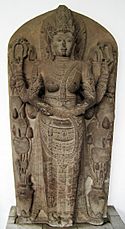
- Tribhuwana Wijayatunggadewi (ruled 1328–1350)
- Suhita (ruled 1429–1447)
- Śri Isyana Tunggawijaya (ruled 947–985)
Mengwi
- Gusti Ayu Istri Biang Agung (ruled 1836–1857)
- Bi Sonbai (ruled 1672–1717), in western Timor
- Tumanurung Baine
- Ratu Nahrasyiyah
- We Banrigau, Mallajange ri Cina
- We Tenrituppu, MatinroE ri Bantaeng
- We Bataritoja, Sultanah Zainab Zulkiyahtuddin (ruled 1714–1715 and 1724–1749)
- We Imaniratu, Sultanah Rajituddin
- We Tenriawaru, Sultanah Ummulhuda
- We Fatimah Banri, Datu Citta
Laos
- Nang Keo Phimpha (ruled 1438) - after her nephew Lan Kham Deng died, she seized control of Lan Xang and the next four kings were under her control. She only reigned for a few months in 1438 at the age of 95; she was then deposed and killed.
Malaysia
- Siti Wan Kembang (ruled 1610–1667)
- Puteri Saadong (ruled 1667–1671)
Myanmar
- Shin Sawbu (ruled 1454–1471)
Philippines
- Kalangitan (ruled 1450–1515)
- Nur ul-Azam (ruled c. 1680–1685)
Thailand
- Jamadevi (6th-7th century), first ruler of the Mon kingdom of Hariphunchai
- Ratu Hijau, 'the Green Queen' (ruled 1584–1616)
- Ratu Biru, 'the Blue Queen' (ruled 1616–1624)
- Ratu Ungu, 'the Purple Queen' (ruled 1624–1635)
- Ratu Kuning, 'the Yellow Queen' (ruled 1635–1649/88), controversy surrounds the exact date of the end of her reign
- Ratu Emas Kelantan (ruled 1670–1698 or 1690–1704) - thought by A. Teeuw & Wyatt to be a king, but claimed by al-Fatani to be a queen, the widow of Raja Bakal and mother of the succeeding queen
- Ratu Emas Chayam (ruled 1698–1702 or 1704–1707 and 1716–1718)
- Chiraprapha (ruled 1545–1546)
- Wisutthi Thewi (ruled 1564–1578)
Timor
- Dona Maria Borromeu Duarte (ruled 1945–1952)
- Dona Maria Amado de Jesus Corte-Real (ruled 1943–1960)
- Dona Catarina de Freitas (ruled 1808–1812)
- Two queens (widows of Dom Lac-Theu and Dom Tai Mau)
- Dona Vasso Bere (ruled 1849-after 1854)
Luca
- Dona Rosa Amaral (ruled 1881–1896)
Jenilu
- Raja Perempuan (ruled 1845)
- Mariana Rosa da Costa (ruled 1879–1893)
Lakekun
- Balok Lorok
- Hoar Teti
Lidak
- Petronella da Costa (ruled 1901–1913)
Sonba'i Kecil
- Usi Tetu Utang (ruled 1672–1717)
Amfoan
- Anna Elisabeth Aunoni (ruled 1881–1902)
Vietnam
- Queen Trưng Trắc (ruled 40–43) - the Trưng sisters (Vietnamese: Hai Bà Trưng; literally: two ladies Trưng) were leaders who rebelled against Chinese rule for three years, and are regarded as national heroines of Vietnam. Her name is Trưng Trắc.
- Lady Triệu (ruled 248)
- Empress Lý Chiêu Hoàng (ruled 1224–1225)
- Isanavarman (ruled ?–653)
West Asia
Iran
- Musa of Parthia (Parthian queen regnant of Iran, ruled 2 BC–4 AD)
- Pourandukht (In Persian: Pourandokht, Sassanid queen regnant and Daughter of Khosrow Parviz, ruled 630 and 631–632)
- Azarmidokht (Sassanid queen regnant, sister of Pourandukht and daughter of Khosrow Parviz, ruled 630–631)
- Anzaze (ruled about 82/81 to 75 BC, following dates on the coins), she appears on coins together with king Kamnaskires III; they perhaps ruled together as on the coins she is called βασιλίσσης (the Genitive case of queen, βασίλισσα - basílissa)
- Abish Khatun (ruled 1264–1284)
- Sati Beg (ruled 1338–1339)
Iraq
- Kubaba of Kish, the only queen on the Sumerian King List (ruled 25th century BC)
- Puabi (ruled c. 26th century BC) - there is a theory that she ruled on her own right
Israel
- Athaliah (ruled 843–835 BC)
- Salome Alexandra (ruled 76–67 BC)
- Salome I (ruled 6 BC-10 AD) - she ruled as Toparch of Jabneh, Ashdod and Phasaelis
- Livia (ruled 10–29) - she ruled as Toparch of Jabneh
- Melisende (ruled 1131–1153) - she ruled with her husband Fulk of Anjou and her son Baldwin III as co-rulers
- Sibylla (ruled 1186–1190) - she ruled with her husband Guy de Lusignan as co-ruler
- Isabella I (ruled 1190/92–1205) - she ruled with her husbands Conrad of Montferrat, Henry of Champagne and Aimery of Cyprus as co-rulers
- Maria (ruled 1205–1212) - she ruled with her husband John of Brienne as co-ruler from 1210
- Isabella II (ruled 1212–1228), also known as Yolande of Jerusalem - she ruled with her husband Frederick II of Hohenstaufen as co-ruler from 1225
Jordan
- Laodice of the Sameans (ruled c. 92 BC) - In the Codex Leidensis, the people of Laodice is Gileadites.
- Chuldu (ruled c. 9–16) - she ruled with her husband Aretas IV Philopatris
- Shaqilath - she ruled with her husband Aretas IV Philopatris
- Shaqilath II - she ruled with her husband Malichus II; after his death she was regent for her son Rabbel II Soter
- Gamilath - she ruled with her brother Rabbel II Soter
Lebanon
- Lucia of Tripoli (ruled 1287 – 1289)
Saudi Arabia
- Zabibe (ruled c. 750–735 BC)
- Samsi (ruled c. 735–710 BC)
- Yatie (ruled c. 710–695 BC)
- Te'elkhunu (ruled c. 695–690 BC)
- Tabua (ruled c. 678–675 BC)
Syria
- Mavia (ruled 375–425) - "The Queen of the Arabs"
- Cleopatra Thea (ruled 126–121 BC) - she ruled with her sons Seleucus V and Antiochus VIII
- Cleopatra Selene I (ruled 82–69 BC) - she ruled with her son Antiochus XIII
- Zenobia (ruled 272) - she ruled mostly as regent for her son but reigned shortly under the regnal name Septimia Zenobia Augusta in 272.
Turkey
- Constance (Princess) (ruled 1130–1163)
- Artemisia I (ruled c. 480 BC)
- Artemisia II (ruled 353–351 BC)
- Ada (ruled 344–340 and 334–326 BC)
- Amastris (ruled c. 300-284 BC)
- Pythodorida (ruled 8 BC–38 AD)
- Orodaltis (ruled c. after 30 BC)
- Melike Mama Hatun (ruled 1191–1200)
- Theodora Megale Komnene (ruled 1284–1285)
- Eirene Palaiologina (ruled 1340–1341)
- Anna Megale Komnene (ruled 1341–1342)
Yemen
- Asma bint Shihab (ruled 1047–1087) - she was the co-ruler of Yemen in co-regency with her cousin and spouse, Ali al-Sulayhi, and later her son, Ahmad al-Mukkaram, and daughter-in-law, Arwa al-Sulayhi. Though there were many female monarchs in the Muslim world, Asma bint Shihab and Arwa al-Sulayhi were the only female monarchs in the Arab world to have had the khutba proclaimed in their name in the mosques as sovereigns.
- Arwa al-Sulayhi (ruled 1067–1138) - she ruled Yemen firstly with her first two husbands and her mother-in-law and then as sole ruler. She was the greatest of the rulers of the Sulayhid Dynasty and was also the first woman to be accorded the prestigious title of hujja in Isma'ili branch of Shi'a Islam, signifying her as the closest living image of God's will in her lifetime.
Central Asia
Uzbekistan
- Tomyris, Queen of the Massagetae (ruled 570-520 BC)
Europe
Albania
Duchy of Durazzo
- Joanna (ruled 1348–1368)
Principality of Albania
- Helena Thopia (ruled 1402–1403)
Principality of Valona
- Komnina Balšić (ruled 1385–1396)
- Ruđina Balšić (ruled 1414–1417)
Andorra
- Isabella (ruled 1398–1413)
- Catherine (ruled 1483–1512, 1513–1517)
- Jeanne d'Albret (ruled 1555–1572)
Armenia
- Erato (ruled 10–2 BC and 6–12 AD)
Austria
- Maria Theresa (Archduchess) (ruled 1740–1780) - she was the only female ruler of the Habsburg dominions and the last of the House of Habsburg. She was the sovereign of Austria, Hungary, Croatia, Bohemia, Mantua, Milan, Lodomeria and Galicia, the Austrian Netherlands and Parma. In some of the Habsburg dominions (such as Hungary, Croatia, Bohemia and Lodomeria and Galicia), she held the title of queen. By marriage, she was also Duchess of Lorraine, Grand Duchess of Tuscany and Holy Roman Empress (all as consort).
Marcomanni
- Fritigil (ruled mid 4th century)
Bosnia
- Jelena Gruba (ruled 1395–1398)
Bulgaria
Odrysian kingdom
- Antonia Tryphaena (ruled 18–38) - she ruled with her son Rhoemetalces II
- Pythodoris II (ruled 38–46) - she ruled with Rhoemetalces III
Croatia
- Mary (ruled 1382–1385 and 1386–1395)
- Maria Theresa (Queen) (ruled 1740–1780)
Cyprus
- Charlotte (ruled 1458–1464)
- Catherine Cornaro (ruled 1474–1489)
- Elizabeth II (reigned 1952–1960)
Czech lands
- Maria Theresa (Queen) (ruled 1740–1780)
Denmark
- Margaret I (ruled 1387–1412) - she was founder of the Kalmar Union, which united the Scandinavian countries for over a century. Margaret is known in Denmark as "Margrethe I" to distinguish her from the current queen. Denmark did not have a tradition of allowing women to rule, so when her son died, she was titled "All-powerful Lady and Mistress (Regent) of the Kingdom of Denmark". She only styled herself Queen of Denmark in 1375, usually referring to herself as "Margaret, by the grace of God, daughter of Valdemar King of Denmark" and "Denmark's rightful heir" when referring to her position in Denmark. Others simply referred to her as the "Lady Queen", without specifying what she was queen of, but not so Pope Boniface IX, who in his letters styled her "our beloved daughter in Christ, Margaret, most excellent queen of Denmark, Sweden and Norway"
- Margaret II (reign 1972–present)
Estonia
- Margaret Sambiria (ruled 1266–1282)
- Christina (ruled 6 November 1632 – 6 June 1654)
- Ulrika Eleonora (ruled 5 December 1718 – 29 February 1720)
- Catherine I (ruled 8 February 1725 – 17 May 1727)
- Anna (ruled 13 February 1730 – 28 October 1740)
- Elizabeth (ruled 6 December 1741 – 5 January 1762)
- Catherine II (ruled 9 July 1762 – 6 November 1796)
Finland
- Margaret I of Denmark (ruled 1389–1412)
- Christina (ruled 1632–1654)
- Ulrika Eleonora (ruled 1719–1720)
Georgia
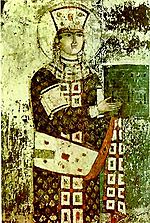
- Dinar of Hereti (ruled 10th-century) - she ruled with her son Ishkhanik
- Tamar of Georgia (ruled 1184–1213)
- Rusudan of Georgia (ruled 1223–1245)
- Tamar of Kartli (ruled 1744–1746) - she ruled with her husband Teimuraz II
Greece
Aeacid dynasty
- Deidamia II (ruled c. 233 BCE)
Byzantine Empire
- Irene of Athens (ruled 797-802) - she normally referred to herself as basilissa (empress), although there are three instances of the title basileus (emperor) being used by her
- Zoë Porphyrogenita (ruled 1028–1041 and 1042–1050) - she ruled with her consorts Romanos III and Michael IV between 1028 and 1041; she ruled with her sister Theodora and her third husband Constantine IX from 1042 to 1050
- Theodora Porphyrogenita (ruled 1042–1056) - she ruled from 1042 jointly with her sister Zoe and Zoe's third husband Constantine IX; she ruled from 1055 until her own death as sole monarch.
Epirus
- Maria Angelina Doukaina Palaiologina (ruled 1384–1385)
Hungary
- Mary (ruled 1382–1385 and 1386–1395) - she was crowned as King of Hungary to emphasize that she was a monarch in her own right; she co-ruled with her husband Sigismund of Luxembourg from 1387
- Maria Theresa (Queen, "King") (ruled 1740–1780)
Iceland
- Margaret I (ruled 1388 – 28 October 1412)
Ireland
Kingdom of Ireland
- Jane Grey (ruled 1553) (disputed)
- Mary I (ruled 1553–1558)
- Elizabeth I (ruled 1558–1603)
- Mary II (ruled 1689–1694) - she co-ruled with her husband William III
- Anne (ruled 1702–1714)
Italy
Naples
- Joan I (ruled 1343–1382)
- Joan II (ruled 1414–1435)
- Joan III the Mad (ruled 1516–1555)
Parma
- Maria Theresa (Duchess) (ruled 1740–1748)
- Marie Louise (Duchess) (ruled 1814–1847)
Sardinia
- Elena of Gallura (ruled 1202 or 1203–1218)
- Benedetta of Cagliari (ruled 1214–1232 or 1233)
- Adelasia of Torres (ruled 1236–1259)
- Joanna of Gallura (ruled 1298–1308)
- Eleanor of Arborea (ruled 1383–1404)
Sicily
- Constance I (ruled 1194–1198) - she co-ruled with her husband Henry VI, Holy Roman Emperor until 1197
- Constance II (ruled 1282–1285) - she co-ruled with her husband Peter III of Aragon
- Maria (ruled 1377–1401) - she co-ruled with her husband Martin I the Younger from 1392
- Joan the Mad (ruled 1516–1555)
Ostrogoths
- Amalasuintha (ruled 534–535) - she ruled first as regent for her son and thereafter as queen regnant in her own right
Luxembourg
- Marie-Adélaïde (Grand Duchess) (ruled 1912–1919)
- Charlotte (Grand Duchess) (ruled 1919–1964)
Malta
- Elizabeth II of Malta (reigned 1964–1974)
Monaco
- Claudine (Lady) (ruled 1457–1458)
- Louise Hippolyte (Princess) (ruled 1731)
Montenegro
- Jelena (ruled 1276–1309)
Netherlands
- Wilhelmina (reigned 1890–1948)
- Juliana (reigned 1948–1980)
- Beatrix (reigned 1980–2013)
Norway
- Margaret (ruled 1388–1412)
Agder
- Åsa (ruled 815–834/38)
Poland
- Jadwiga (ruled 1384–1399) - she was crowned as King of Poland to emphasize that she was a monarch in her own right; she co-ruled with her husband Władysław II Jagiełło from 1386
- Anna (ruled 1575–1586) - she was crowned as King of Poland and Grand Duke of Lithuania to emphasize that she was a monarch in her own right; she co-ruled with her husband Stephen Báthory
Portugal
- Theresa (ruled 1116–1121, disputed)
- Beatrice (ruled 1383–1385, disputed)
- Maria I (ruled 1777–1816)
- Maria II (ruled 1826–1828 and 1834–1853)
Russia
- Irina Godunova (ruled 1598, disputed) - she reigned for just nine days after her husband's death.
- Catherine I (ruled 1725–1727)
- Anna (ruled 1730–1740)
- Elizabeth (ruled 1741–1762)
- Catherine II ("the Great") (ruled 1762–1796)
Sabir people
- Queen Boa, also known as Boareks (ruled 520s)
Kingdom of the Cimmerian Bosporus
- Dynamis (ruled in 47 BC, 44-17 BC and 16-14 BC) - she co-ruled with her first husband Asander in 47 BC and from 44 BC until 17 BC; then she co-ruled with her second husband Polemon I from 16 BC until her death
- Gepaepyris (ruled 38–45) - she ruled in association with her son Mithridates III
Khanate of Qasim
- Fatima Soltan (ruled 1679–1681)
Spain
- Urraca of León and Castile (ruled 1109–1126) - also styled as Empress of all the Spains (totius Hispaniae imperatrix). Her use of the imperial styling was limited, much more so than that of her predecessor and successor (it is possible that the imperial style had connotations too strongly masculine). Urraca did employ instead the title Queen of Spain on several occasions from the very beginning of her reign until the end
- Petronila of Aragon (ruled 1137–1164)
- Berenguela of Castile the Great (ruled 1217)
- Sancha of León (ruled de jure 1230) - she ruled jointly with her sister Dulce. After the death of Sancha's brother, Alfonso IX named his second son, Ferdinand, his heir, bestowing on him the title infante. In 1217, Ferdinand's mother, Berengaria, inherited the Kingdom of Castile, but ceded it to her son. With his heir out of the kingdom and ruling in another place, Alfonso attempted to make his eldest daughters his joint heirs. In the Treaty of Boronal concluded with Portugal in 1219, Alfonso expressly states that if he should die, Portugal should respect the agreement with his daughters. Alfonso also attempted to secure his eldest daughter's rights by marrying Sancha to John of Brienne, the former King of Jerusalem, but his wife Berengaria blocked this action in order to advance her son. After this fiasco, Alfonso declared Sancha and Dulce his heirs, but upon his death on 24 September 1230, the people of León, who had pledged for Ferdinand in 1206, refused to recognise his daughters, and they in turn ceded their rights to his kingdom to their half-brother
- Dulce of León (ruled de jure 1230) - she ruled jointly with her sister Sancha
- Isabella I of Castile the Catholic (ruled 1474–1504) - After a struggle to claim her right to the throne, she reorganised the governmental system, brought the crime rate to the lowest it had been in years, and unburdened the kingdom of the enormous debt her brother had left behind. Her marriage with Ferdinand II of Aragon brought stability to the kingdoms that became the basis for the political unification of Spain. Her reforms and those she made with her husband had an influence that extended well beyond the borders of their united kingdoms. Isabella and Ferdinand are known for completing the Reconquista, ordering conversion or exile of their Muslim and Jewish subjects in the Spanish Inquisition, and for supporting and financing Christopher Columbus's 1492 voyage that led to the opening of the New World.
- Joanna of Castile and Aragon the Mad (ruled 1504–1555) - successor of the previous. After her husband's death she was deemed mentally ill and was confined to a nunnery. Her father, Ferdinand II of Aragon, was regent until his death, when she inherited his kingdom as well and began her nominal co-reign with her son Charles I of Spain, but she had no actual power and her confinement lasted until her death.
- Isabella II of Spain (ruled 1833–1868)
- Toda Aznárez (ruled 950s-970s) - was the queen consort of Pamplona through her marriage to Sancho I, who reigned from 905 to 925, and was regent of Pamplona for her son García Sánchez I from 931 to 934. Later in life, she ruled a subkingdom created for her
- Joan I (ruled 1274–1305)
- Joan II (ruled 1328–1349)
- Blanche I (ruled 1425–1441)
- Blanche II (ruled de jure 1461–1464)
- Eleanor (ruled in 1479)
- Catherine (ruled 1483–1517)
- Joan III (ruled 1555–1572)
Sweden
- Margaret (ruled 1389–1412)
- Christina (ruled 1632–1654) - she was crowned as King of Swedes, Goths and Vandals to emphasize that she was a monarch in her own right
- Ulrika Eleonora (ruled 1718–1720)
Ukraine
Kingdom of Galicia and Lodomeria
- Maria Theresa (ruled c. 1772–1780)
United Kingdom
Kingdoms of the Britons
- Cartimandua (ruled c. 43–69), queen of the Brigantes, a Celtic people in what is now Northern England - she came to power around the time of the Roman conquest of Britain, and formed a large tribal agglomeration that became loyal to Rome; she is known exclusively from the work of a single Roman historian, Tacitus, though she appears to have been widely influential in early Roman Britain
- Boudica (ruled c. 60–61), queen of the Brythonic Celtic Iceni, people of Norfolk, in Eastern Britain - in 61 AD, led a major uprising of the tribes against the occupying forces of the Roman Empire
Anglo-Saxon kingdoms
- Seaxburh of Wessex (ruled c. 672–674) - she reigned jointly with her husband Cenwalh and, according to tradition, ruled Wessex as Queen for a year following Cenwalh's death in c. 672
- Æthelflæd of Mercia (ruled 911–918) - eldest daughter of king Alfred the Great of Wessex, wife of Æthelred II, ealdorman of Mercia, and after his death, sole ruler of Mercia. While her husband was alive, she signed agreements, leading some to think that she was the real leader. The Anglo-Saxon Chronicle styles her Lady of the Mercians (Myrcna hlæfdige)
- Ælfwynn of Mercia (ruled 918) - daughter of Æthelflæd and Æthelred II, styled Lady of the Mercians. Deposed by her uncle, Edward the Elder (4 December 918), who annexed Mercia to Wessex, creating the Kingdom of England
Kingdom of England
- Matilda (ruled 1141) - she was England's first de facto female ruler, holding the title of Lady of the English (she planned to assume the title of queen upon her coronation). She was declared heir presumptive by her father, Henry I, and acknowledged as such by the barons; however, upon the death of her father in 1135, Matilda's rival and cousin Stephen of Blois usurped the throne. The Anarchy followed, with Matilda's being a de facto ruler for a few months in 1141, but she was never crowned and failed to consolidate her rule (legally and politically)
- Jane (ruled 1553, disputed) - her cousin Edward VI of England nominated Jane as successor to the Crown in his will and excluded his half sisters, Mary and Elizabeth. However, this was disputed following Edward's death, since parliament had not ratified his action and Jane was ‘queen’ for only nine days (10–19 July) before Edward's half-sister, Mary, was proclaimed Queen. Jane is nicknamed The Nine Days' Queen
- Mary I (ruled 1553–1558)
- Elizabeth I (ruled 1558–1603)
Kingdom of Scotland
- Margaret, Maid of Norway (ruled 1286–1290) She was daughter of Eric II of Norway and Margaret of Scotland and was named "domina and right heir" of the Kingdom of Scotland by her grandfather, Alexander III. Her death, at the age of seven, while en route to Scotland sparked off the disputed succession which led to the Wars of Scottish Independence. As Margaret was never crowned or otherwise inaugurated, and never set foot on what was then Scottish soil during her lifetime, there is some doubt about whether she should be regarded as a Queen of Scots; this could ultimately be a matter of interpretation. Most lists of the monarchs of Scotland do include her, but a few do not.
- Mary I (ruled 1542–1567) - she was executed in England in 1587
Kingdoms of England and Scotland / Kingdom of Great Britain
- Mary II (reigned 1689–1694, jointly with her cousin and husband William III of Orange)
- Anne (reigned 1702–1714)
United Kingdom
- Victoria (reigned 1837–1901) - the first monarch to hold the title of Empress of India.
- Elizabeth II (reigning 1952–present) - head of state of 15 sovereign states, longest-reigning British monarch, longest-reigning queen regnant and female head of state in world history and, since October 2016, the longest currently reigning monarch and head of state.
Oceania
American Samoa
- Tuimanufili, (ruled as 20th Tui Manu'a)
- Siliave, (ruled as 23rd Tui Manu'a)
- Seuea, (ruled as 27th Tui Manu'a)
- Matelita, (ruled 1891–1895, as 39th Tui Manu'a)
Australia
- Victoria (ruled 1901)
- Elizabeth II of Australia (reigning 1952–present)
French Polynesia
Bora Bora
- Teriimaevarua II (ruled 1860–1873)
- Teriimaevarua III (ruled 1873–1895)
Huahine
- Teha'apapa I (ruled 1760–1790)
- Teri'itaria II (ruled 1815–1852)
- Teha'apapa II (ruled 1868–1893)
- Teuhe (ruled 1888–1890) - she reigned under a rebellion government against her mother Queen Tehaapapa II
- Teha'apapa III (ruled 1893–1895)
Raiatea
- Tehauroarii (ruled 1881–1884)
- Tuarii (ruled till 1897) – she reigned under a rebellion government against the French with the support of Teraupo'o after Tamatoa VI abdicated.
Rapa Iti
- Daughter of Parima (ruled 1886–1887).
Rimatara
- Tamaeva IV (ruled 1876–1892)
- Tamaeva V (ruled 1892–1901)
Tahiti
- Purea (ruled 18th century), queen of the Teva clan on the southern part of the island before unification
- Pōmare IV (ruled 1827–1877)
Fiji
- Elizabeth II of Fiji (reigned 1970–1987)
Hawaii
- Ancient
- Kalanikauleleiaiwi, co-ruler of Hawaiʻi Island along with her brother Keaweʻīkekahialiʻiokamoku (ruled 1695–1725)
- Ululani, 7th Chiefess of Hilo
- Kapauanuakea, 3rd Chiefess of Molokai
- Kamauliwahine, 4th Chiefess of Molokai
- Hualani, 5th Chiefess of Molokai
- Kanealai, Chiefess of Molokai
- Kūkaniloko, 11th Moʻi of Oʻahu (ruled sixteenth century)
- Kalaimanuia, 12th Moʻi of Oʻahu (ruled 1600–1665)
- Kaikilani, 17th Moʻi of Hawaiʻi Island (ruled 1575–1605)
- Keakamahana, 19th Moʻi of Hawaiʻi Island (ruled 1635–1665)
- Keakealaniwahine, 20th Moʻi of Hawaiʻi Island (ruled 1665–1695)
- Kamakahelei, 22nd Moʻi of Kauaʻi (ruled 1770–1794)
- Kingdom
- Liliʻuokalani (ruled 1891–1893 and claimed status as queen until her death in 1917) - was one of many queens of Hawaii; however, she was the only queen regnant of the modern Kingdom of Hawaii established by Kamehameha I in the late eighteenth century
New Zealand
- Elizabeth II of New Zealand (reigning 1952–present)
Rarotonga
- Makea Takau Ariki, Queen/Supreme High Chiefess of the Cook Islands (ruled 1871–1911) - was the last monarch and only queen regnant of the Kingdom of Rarotonga established in 1858, she ceased to be sovereign after 1888
Papua New Guinea
- Elizabeth II of Papua New Guinea (reigning 1975–present)
Solomon Islands
- Elizabeth II of Solomon Islands (reigning 1978–present)
Tonga
- Tupoumahe'ofo (ruled 1777–1781, as Tu'i Kanokupolu)
- Salote Tupou III (ruled 1918–1965)
Tuvalu
- Elizabeth II of Tuvalu (reigning 1978–present)
Uvea (Wallis)
- Toifale (ruled 1825)
- Falakika Seilala (ruled 1858–1869)
- Amelia Tokagahahau Aliki (ruled 1869–1895)
- Aloisia Brial (ruled 1953–1958)
Female regents
Africa
Ashanti Empire
- Yaa Asantewaa (c. 1840–1921) (regent), queen mother of Ejisu in the Ashanti Empire (1894-1902)
Axum Empire
Dahomey
- Hangbe (regent) ruler of Dahomey 1716-1718 between the death of Akaba and the rule of Agaja
Egypt
- Neithhotep of the First Dynasty - likely ruled as regent on behalf of either Hor-Aha or Djer. Her exceptional status may point to her being a ruling Pharaoh in her own right, but this is disputed among Egyptologists.
- Merneith of the First Dynasty - was a consort and a regent of Ancient Egypt during the First Dynasty during the early part of the reign of her son Den. She may have been a ruler of Egypt in her own right (hence being included in the list of queens regnant as well). The possibility is based on several official records. Her rule occurred the 30th century B.C., for an undetermined period
- Nimaathap of the Second Dynasty - possibly ruled as regent on behalf of her son Djoser.
- Khentkawes I of the Fourth Dynasty - Khentkawes may have served as a regent for Thampthis (considered by some historians her son), or she may have ruled Egypt as Pharaoh.
- Khentkaus II of the Fifth Dynasty - While it is not confirmed that Khentkaus ruled as regent, several aspects of her tomb indicate she may have done so.
- Iput I of the Sixth Dynasty - possibly ruled as regent on behalf of her son Pepi I.
- Ankhesenpepi II of the Sixth Dynasty - ruled as regent on behalf of her son Pepi II.
- Ahhotep I of the Seventeenth Dynasty - ruled as regent on behalf of her son Ahmose I.
- Ahmose-Nefertari of the Eighteenth Dynasty - ruled as regent on behalf of her son Amenhotep I. Was later deified as a goddess in the centuries after her death.
- Hatshepsut of the Eighteenth Dynasty - was initially regent on behalf of her step-son Thutmose III, before becoming a reigning co-ruling Pharaoh in her own right.
- Mutemwiya of the Eighteenth Dynasty - ruled as regent on behalf of her son Amenhotep III.
- Twosret of the Nineteenth Dynasty - ruled as regent on behalf of her step-son Siptah and became ruling Pharaoh after his death.
- Sitt al-Mulk - regent from 1021 to 1023 during the reign of her nephew Ali az-Zahir.
- Rasad - While never formally regent, she wielded a great deal of power during the reign of her son Al-Mustansir Billah and was the effective head of state from 1044 to 1062.
- Shajar al-Durr - de facto regent from November 1249 to February 1250.
Ethiopia
- Eleni (regent) 1507-1516
- Mentewab (regent) 1723-1730
- Ga'ewa, regent of Mäzäga
- Genne Fa, regent of Kingdom of Gera
Kongo Kingdom
- Isabel Maria da Gama (regent) 1962-1975
Mwali
- Ravao (1840s) - regent during the early years of the reign of her daughter Djoumbé Fatima.
Sultanate of Tuggurt
- Aisha (regent)
Batlokwa
- Mmanthatisi (1813-1824) - regent on behalf of her son Sekonyela.
America
Aztec Empire
Yaxchilan
- Ik' Skull, also known as Lady Eveningstar (possibly ruled 742–752)
Asia
Abbasid Caliphate
- Al-Khayzuran (regent) 775-789 - de facto regent during the reigns of her husband Al-Mahdi and her sons Al-Hadi and Harun al-Rashid
- Shaghab (regent) 908-932 - de facto regent during the reign of her son Al-Muqtadir
Bhopal State
- Sikandar Begum (regent) 1844-1860 - regent on behalf of her daughter Shah Jahan Begum before becoming the Nawab of Bhopal from 1860 to 1868. She was succeeded by her daughter.
China
- Empress Lü
- Wang Zhengjun
- Empress Dou (Zhang)
- Deng Sui
- Yan Ji
- Liang Na
- Dou Miao
- Empress He (Han dynasty)
- Wu Zetian - she ruled first as regent and thereafter as empress regnant in her own right
- Empress Wei (Tang dynasty)
- Xiao Puxiannü
India
- Lakshmibai, regent for her adopted son Damodar Rao
- Kittur Chennamma, regent for her adopted son Shivalingappa
Gond
- Rani Durgavati (regent) ?–1564
Maratha Empire
- Tarabai (regent) 1700–1708
Iran
- Atossa (regent) 522 BC-475 BC
Korea
Goguryeo
- Queen Mother Buyeo, regent for King Taejo
Silla
- Queen Jiso, regent for King Jinheung
- Queen Gyeongsu, regent for King Hyegong
Goryeo
- Queen Cheonchu, regent for King Mokjong
- Queen Sasuk, regent for King Heonjong
- Princess Deoknyeong, regent for King Chungmok and King Chungjeong
- Queen Gongwon, regent for King U
Joseon
- Queen Jeonghui, regent for King Yejong and King Seongjong
- Queen Munjeong, regent for King Myeongjong
- Queen Insun, regent for King Seonjo
- Queen Jeongsun, regent for King Sunjo
- Queen Sunwon, regent for King Heonjong and King Cheoljong
- Queen Sinjeong, regent for King Gojong
Mongolia
- Töregene Khatun (regent) 1243–1246
- Oghul Qaimish (regent) 1248–1251
- Mandukhai Khatun (regent) 15th century
Chagatai Khanate
- Orqina Khatun (regent) 1252-1260
Golden Horde
- Tulun Beg Khanum (regent) 1370-1373
Kara-Khitan Khanate
- Tabuyan (regent) 1144-1150
- Yelü Pusuwan (regent) 1164–1178
Kashmir
- Didda (regent) 958-980 - she ruled first as a regent for her son and thereafter as sole ruler in her own right
Kazan Khanate
- Söyembikä (regent) (1549-1551)
Neo-Assyrian Empire
- Shammuramat (regent) 810-806 BC
Palmyrene Empire
- Zenobia (regent) 267–271
Ryukyu Kingdom
- Ogiyaka (regent)
Thailand
- Sri Bajarindra (regent) 1862–1955
- Sirikit (regent) 1950-2016
Vietnam
- Queen Cù thị (regent) 113–112 BC
- Empress Dương Vân Nga (regent) 979–981
- Empress Thượng Dương (regent) 1072–1073
- Lady Ỷ Lan (first regent 1069–1070) (second regent 1072–1085(6,?))
- Empress Linh Chiếu (regent) 1138–1158
Europe
Armenia
- Zarmandukht (regent) 378–384
England
- Ælfthryth (regent) 978-984
- Matilda of Flanders - ruled as regent during the absences of her husband, William the Conqueror.
- Eleanor of Aquitaine (regent) 1190-1191
- Eleanor of Provence (regent) 1253
- Isabella of France (regent) 1326-1330
- Philippa of Hainault (regent) 1346
- Joan of Navarre (regent) 1399-1403 and 1415
- Catherine of Aragon (regent) six months in 1513
- Catherine Parr (regent) July–September 1544
France
- Balthild (regent) 657-659
- Anne of Kiev (regent) 1060-1066
- Adela of Champagne (regent) 1190
- Blanche of Castile (regent) 1226-1235 and 1248-1252
- Isabella of Bavaria (regent) 1417-1420
- Joan the Lame - ruled as regent while her husband, Philip VI of France, fought in the Hundred Years' War.
- Catherine de' Medici (regent) in 1552, 1560-1563 and in 1574
- Marie de' Medici (regent) 1610-1614
- Anne of Austria (regent) 1643-1651
- Maria Theresa of Spain (regent) 1667, 1672, 1678
- Marie Louise (regent) 1812 and 1814
- Eugénie de Montijo (regent) 1859, 1865 and 1870
Franks
- Richilde of Provence (regent) 877
- Fredegund (regent) 584-597
- Ermentrude of Orleans 823-869
Illyrian Kingdom
Khazar
- Parsbit (regent) 730
Kievan Rus'
- Olga (regent) 945-962
Netherlands
- Emma (regent) 1890-1898
Lombards
- Theodelinda (regent) 590-591
Ostrogoths
- Amalasuntha (regent) 526-534
- Elizabeth (regent) 1370-1376
Portugal
- Leonor Teles (regent) 1383-1384
- Eleanor of Aragon (regent) 1438-1439
- Eleanor of Viseu (regent) 1497-1499
- Catherine of Austria (regent) 1557-1562
- Luisa de Guzmán (regent) 1656-1662
- Catherine of Braganza (regent) 1701; 1704-1705
- Maria Anna of Austria (regent) 1742-1750
- Mariana Victoria of Spain (regent) 1776-1777
Russia
- Sophia of Lithuania (regent) 1425-1432
- Elena Glinskaya (regent) 1533-1538
- Natalya Naryshkina (regent) 1682
- Sophia Alekseyevna (regent) 1682–1689
- Anna Leopoldovna (regent) 1740-1741
Sarmatians
- Amage (ruled fl. 2nd-century)
Sweden
- Ingeborg (de facto regent 1318–1319) (de jure regent 1319–1326)
- Hedwig Eleanor (regent) 1660-1672 & 1697
Roman Empire and immediate successors
- Agrippina the Younger (regent) 49 - 56, as Augusta of the Roman Empire, ruled during the time of her husband and son.
- Julia Domna (regent) 197 - 217, as Augusta of the Roman Empire, ruled during the time of her husband and sons and she was the first woman in the Severan dynasty to rule.
- Julia Maesa (regent) 218 - 224, The Severan dynasty was dominated by powerful women, one of which was Maesa. She was politically able and ruthless and held power until she died in Rome.
- Julia Soaemias (regent) 218 - 222, After his son came to power, he came to power with his mother and She attended meetings of the senate, and even held a "Women's Senate" deciding on matters of fashion and protocol. She was honored with various titles, including 'Augusta, mater Augusti' (Augusta, mother of Augustus) and 'Mater castorum et senatus et totius domus divinae' (Mother of camp and the senate and the divine house).
- Julia Avita Mamaea (regent) 222 - 235, She was the mother of Roman Emperor Alexander Severus and served as regent of Rome during his minority, de facto during his reign. also Alexander confirmed his esteem for his mother and named her consors imperii (imperial consort).
- Ulpia Severina (regent) 275 - there is considerable numismatic evidence for Ulpia Severina ruling in her own right between the death of Aurelian and the election of Marcus Claudius Tacitus. Sources mention an interregnum between Aurelian and Tacitus, and some of Ulpia's coins appear to have been minted after Aurelian's death. As such she may have been the only woman to rule over the whole Roman Empire in her own power.
Bithynia
- Etazeta (regent) 255–254 BC
Byzantine Empire
- Pulcheria (regent) 414–453
- Irene of Athens (as regent, ruled 780–790 and 792–797) - she ruled first as regent for her son and thereafter as empress regnant in her own right
- Martina (empress) (regent) 613–641
- Theodora the Armenian (regent) - but some historians regard her as a empress regnant rather than just a regent
- Eudokia Makrembolitissa (regent) - but some historians regard her as a empress regnant rather than just a regen
Latin Empire
- Yolanda of Flanders (regent) 1217-1219
Ottoman Empire
- Mahpeyker Kösem Sultan (regent) 1623-1632 and 1648-1651
- Turhan Hatice Sultan (regent) 1651-1656
Legendary Queens
Algeria
Cambodia
- Queen Somâ of Funan Kingdom (ruled 180–90 BCE) - the earliest Queen and Leader in Cambodian history
Chile
- Vakai of Rapa Nui
China
Czech
Ethiopia
- Further information: List of legendary monarchs of Ethiopia
Claimed dates follow the Ethiopian calendar
- Borsa (4321–4254 BC)
- Elyouka (3776–3731 BC)
- Nehasset Nais (2434–2404 BC)
- Kasiyope (1890–1871 BC) – Originated from Greek mythology
- Mumazes (1675–1671 BC)
- Aruas (1671 BC)
- Helena (1358–1347 BC)
- Makeda (1013–982 BC) – The Biblical queen of Sheba in Ethiopian tradition
- Nicauta Kandake (740–730 BC)
- Hadina (372–362 BC)
- Nikawla Kandake (342–332 BC)
- Akawsis Kandake (325–315 BC)
- Nikosis Kandake (242–232 BC)
- Awsena (99–88 BC)
- Nicotnis Kandake (35–25 BC)
- Garsemot Kandake (40–50 AD)
- Wakana (230 AD)
- Ahywa Sofya (299–332 AD) – Likely based on Sofya of Axum
- Adhana I (369–374 AD)
- Adhana II (412–418 AD)
Gideons Dynasty
- Gudit, (ruled c. 960 – c. 1000)
Sidama people
Greece
Amazons
- Otrera, the daughter of Eurus (the east wind)
- Hippolyta, the Amazonian queen who possessed a magical girdle
- Penthesilea, the daughter of Ares and Otrera and the sister of Hippolyta, Antiope and Melanippe
- Antianara, the daughter of Ares and Otrera and the sister of Hippolyta, Antiope and Melanippe
- Eurypyle
- Lampedo
- Marpesia
India
Iran
Iraq
- Kubaba of Kish, the only queen on the Sumerian King List (ruled 25th century BC)
- Semiramis, the legendary queen of king Ninus, succeeding him to the throne of Assyria
- Nitocris of Babylon, the ruling queen of Babylon described by Herodotus in his Histories
Ireland
Italy
Japan
- Empress Jingū (ruled 201–269)
- Iitoyo
Libya
Malaysia
Mongolia
- Alan Gua, a mythical figure from the Secret History of the Mongols
Myanmar
Poland
Somalia
- Amel Ali of Somali mythology
- Arawelo of Proto-Somali
Sudan
- Karimala of Nubia (depicted in Semna)
- Pelekh Candace of Meroë (c. 345–332 BCE)
Tunisia
Turkey
- Zugalum of Harran (ruled 2400 BC)
United Kingdom
- Queen Gwendolen (ruled 11th century BCE)
- Queen Cordelia (ruled 8th century BCE)
- Queen Marcia (ruled 4th century BCE)
Vietnam
- Lady Po Nagar of Champa, According to Cham legend, was the founder of the Cham nation
- Âu Cơ
Yemen
- Bilkis in Yemen, claimed to be Queen of Sheba
Titular Queens
Botswana
- Mosadi Seboko (ruled 2002–present), the kgosikgolo of the Balete people
Brazil
- Isabel, titular empress regnant of Brazil
Chile and Argentina
- Laure-Therese Cros, pretender to throne of Kingdom of Araucanía and Patagonia (ruled 1903–1916)
Haiti
Italy
- Catherine I, titular empress regnant of Latin Empire
- Catherine II, titular empress regnant of Latin Empire
Korea
- Yi Hae-won, titular empress regnant of Korean Empire (ruled 2006–2020)
Mexico
- María Josepha, titular empress regnant of Mexico
New Zealand
- Te Atairangikaahu, queen of Māori (ruled 1966–2006)
Nigeria
- Ahebi Ugbabe
Panama and Costa Rica
- Rufina Santana, queen of Naso people (ruled 1982–1988)
Chieftainess
Burundi
Fiji
- Lala Mara, the Roko Tui Dreketi of Rewa (ruled 1957–2004)
- Teimumu Kepa, the Roko Tui Dreketi of Rewa (ruled 2004–present)
Haiti and Dominican Republic
- Anacaona, Cacica of Quisqueya
- Iguanamá, Cacica of Hispaniola, also known as Isabel de Iguanamá (ruled c. 1514)
Israel
- Deborah, the only female judge of Israelite tribes in Biblical judges
New Zealand
Rarotonga
- Makea Te Vaerua Ariki, High Chiefess of Te Au O Tonga (ruled 1845–1857)
- Pa Upoko Takau Ariki, High Chiefess of Takitumu (ruled 1855–1890)
- Tinomana Mereana Ariki, High Chiefess of Puaikura (ruled 1881–1908)
Nigeria
South Africa
Xhosa
- Nosizwe Tyali, Chief of Imingcangathelo
- Nosiseko Gaika, Chief of Amambombo (Ngqika)
- Nomasilakhe Komani, Chief of Imingqalasi
United States and Canada
Crow tribe
- Pine Leaf (ruled 1830s)
Giluts'aaw
- Victoria Young
Pamunkey
- Cockacoeske (ruled 1656–1686)
- Queen Betty (ruled 1686–1708)
- Queen Ann (ruled 1708–1723)
Puerto Rico
- Doña Ines, mother of Caciques Agueybaná and Agüeybaná II
- Doña María, daughter of Cacique Bagnamanay
- Yuisa, Cacica in the region near Loíza, Puerto Rico
Sakonnet
Seneca tribe
- Queen Alliquippa (ruled 1754)




